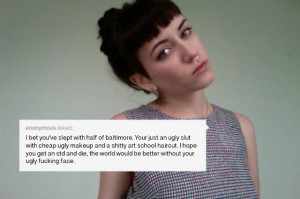The Selfie/Troll Dynamic
Lindsay Bottos, a Baltimore artist, has created a selfie presentation that includes a selection of the troll comments she receives on a regular basis.
Ms. Bottos’ presentation provides many discussion opportunities about the selfie phenomenon, but also about trolling and the license to criticize that anonymity seems to engender in some people.
In the two frames from the exhibition selected here, anonymous trolls have made very strong statements. The first reads: “I can tell you Photoshop your pictures to make yourself skinnier. Too bad I know what you look like IN REAL LIFE. Get your fat ass off tumbler and go run or something jesus”
This troll has made several assumptions: the image has been manipulated; it has been manipulated for a specific purpose; Ms. Bottos wants to appear skinnier; Ms. Bottos needs to run. The tweet reveals a great deal about the troll. The troll has given himself/herself permission to judge the image, its intent, the artist and to suggest a remedy for what he/she believes is wrong. Why might someone assume that they know so much from an image? Why might someone think that they have the right to express such strong and negative thoughts? Why has their anonymity enabled them to be so judgmental and harsh?
The comment in the second frame reads, “I bet you slept with half of Baltimore Your just an ugly slut with cheap ugly make up and shitty art school haircut. I hope you get an std and die, the world would be better without your ugly fucking face”
The second troll has also made great inferential leaps: Ms. Bottos is monumentally promiscuous. He/she also passes judgment on her inferred behavior: she should get an STD and die from it.
What is interesting are the elaborate imagined contexts the trolls create in their tweets. They go beyond commenting on the image to commenting on their inferred contexts for the images. They reject the notion that these images are artistic representations. They insist that Ms. Bottos is desperate for attention and they believe that they have the right to deny her self-expression.
Review the full exhibition, then consider some of these questions.
Why might artists post selfies?
What artistic statements might the selfies be making?
How might people feel when they create art and receive these responses?
What are the effects of juxtaposing a response with a selfie?
What do these responses reveal about the trolls who wrote them?
Should art and artists be respected, or must public exhibition include risks like receiving these comments?
Have there always been haters, or is this a new social media phenomenon?
Can you infer, using word choice, grammar, and sentence structure, whether these comments have been made by males or females?
Are these comments appropriate to the art? What comments might be more appropriate?
How might demeaning comments demean the people who make them more than the people who receive them?
How might Ms. Bottos’ exhibition help people understand the online treatment of women?
What might people who view the exhibition learn about trolling?
Are many of the issues involving trolling similar to issues about bullying?
How might bullying be different?
(These ideas can be adapted to older Elementary and Secondary students – ed.)






